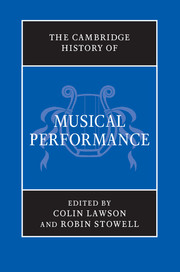Book contents
- Frontmatter
- PART I PERFORMANCE THROUGH HISTORY
- PART II PRE-RENAISSANCE PERFORMANCE
- PART III PERFORMANCE IN THE RENAISSANCE (C. 1430–1600)
- PART IV PERFORMANCE IN THE SEVENTEENTH CENTURY
- PART V PERFORMANCE IN THE ‘LONG EIGHTEENTH CENTURY’
- PART VI PERFORMANCE IN THE NINETEENTH CENTURY
- 24 Performance in the nineteenth century: an overview
- 25 Vocal performance in the nineteenth century
- 26 Instrumental performance in the nineteenth century
- 27 Case study: Richard Wagner, Tristan und Isolde
- PART VII THE TWENTIETH CENTURY AND BEYOND
- PART VIII
- Index
25 - Vocal performance in the nineteenth century
from PART VI - PERFORMANCE IN THE NINETEENTH CENTURY
Published online by Cambridge University Press: 28 March 2012
- Frontmatter
- PART I PERFORMANCE THROUGH HISTORY
- PART II PRE-RENAISSANCE PERFORMANCE
- PART III PERFORMANCE IN THE RENAISSANCE (C. 1430–1600)
- PART IV PERFORMANCE IN THE SEVENTEENTH CENTURY
- PART V PERFORMANCE IN THE ‘LONG EIGHTEENTH CENTURY’
- PART VI PERFORMANCE IN THE NINETEENTH CENTURY
- 24 Performance in the nineteenth century: an overview
- 25 Vocal performance in the nineteenth century
- 26 Instrumental performance in the nineteenth century
- 27 Case study: Richard Wagner, Tristan und Isolde
- PART VII THE TWENTIETH CENTURY AND BEYOND
- PART VIII
- Index
Summary
The nineteenth century, which produced the majority of the music that is still sung in concert halls and opera houses today, also saw changes in the art of singing more rapid and more radical than seem to have occurred in any previous century – to be surpassed in extent only by those of the twentieth. At its beginning, the great majority of professional public singers (outside churches at any rate) were still native Italians, expounding a tradition whose predominance all Europe had embraced for centuries; operas were still tailored to the immediate members of their casts and mostly forgotten (or re-tailored) soon after; the solo singer in many genres was still a kind of co-composer, responsible through ornamentation for much of the surface detail of his music. By its end, Germany, France and Russia had operatic repertoires of interest beyond their own borders; a vast new repertoire of piano-accompanied song had arisen (and commanded the attention of leading composers) outside Italy; contemporary opera had banished improvisation and embraced modern symphonic procedures; and – though Italians could still lay some claim to pre-eminence – the vocal profession had become thoroughly cosmopolitan. In 1800 Haydn was still active, Mozart was a living memory to thousands, and the odd virtuosi we call castrati were still performing and teaching. In 1900 Verdi had retired, Mahler was running the Vienna State Opera, Pelléas and Jenufa were just around the corner, and Feodor Chaliapin had already started to give new meanings to the idea of the ‘singing actor’.
- Type
- Chapter
- Information
- The Cambridge History of Musical Performance , pp. 611 - 642Publisher: Cambridge University PressPrint publication year: 2012



